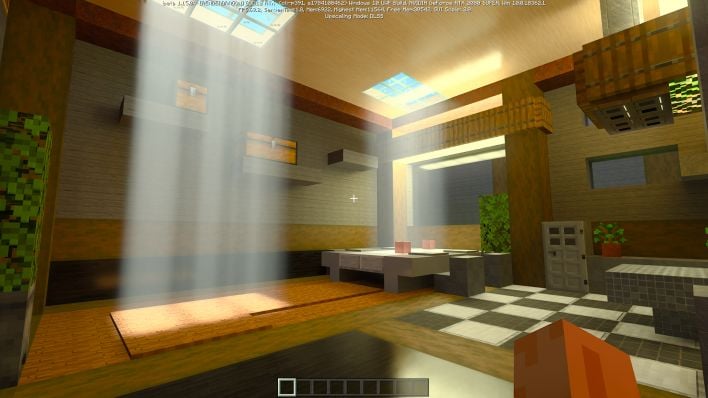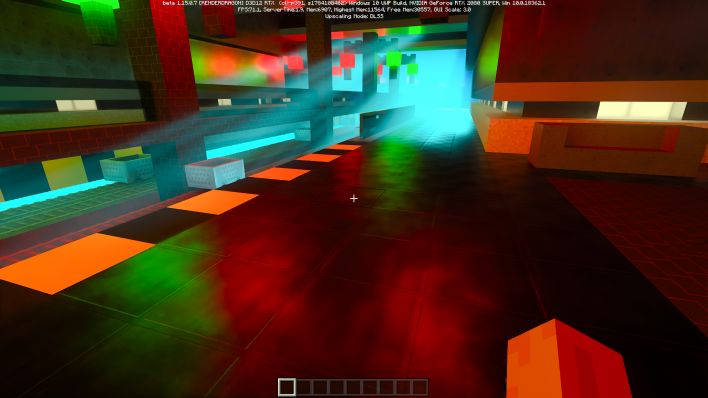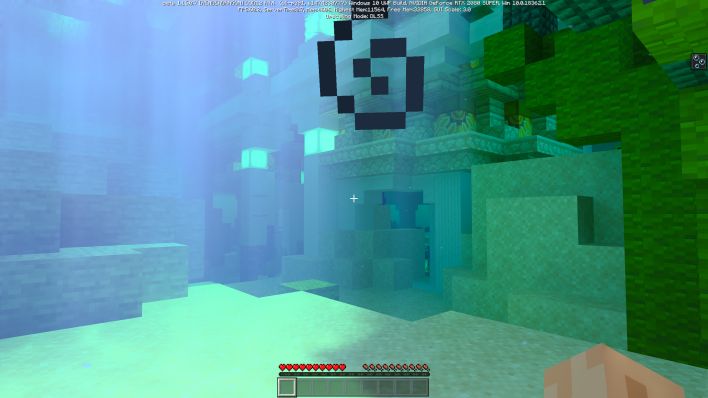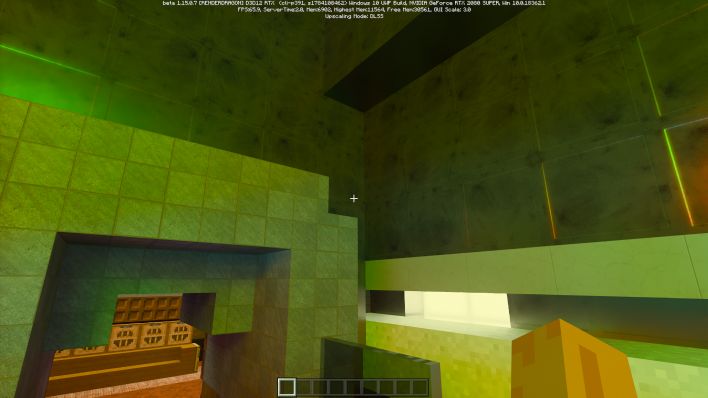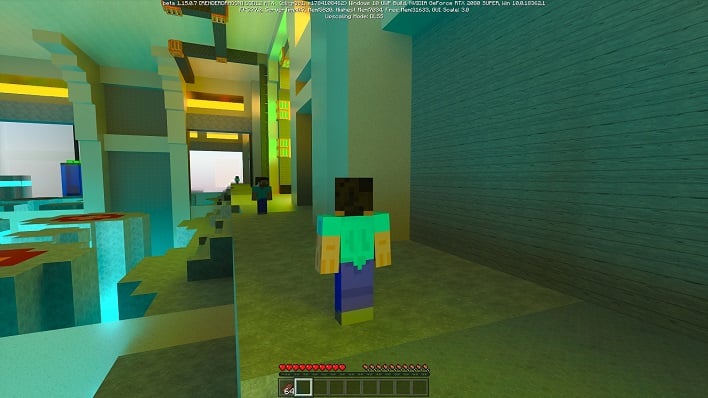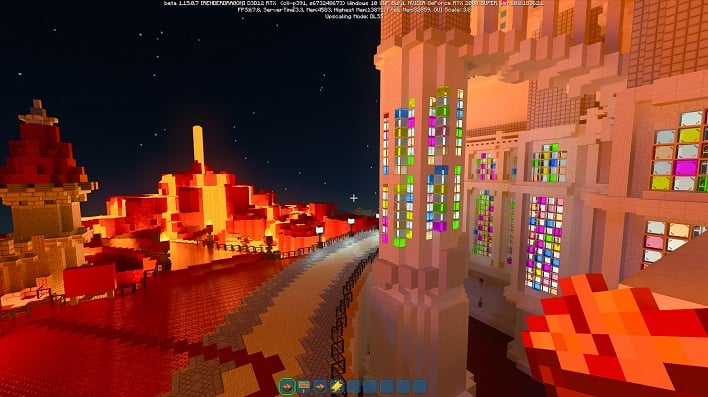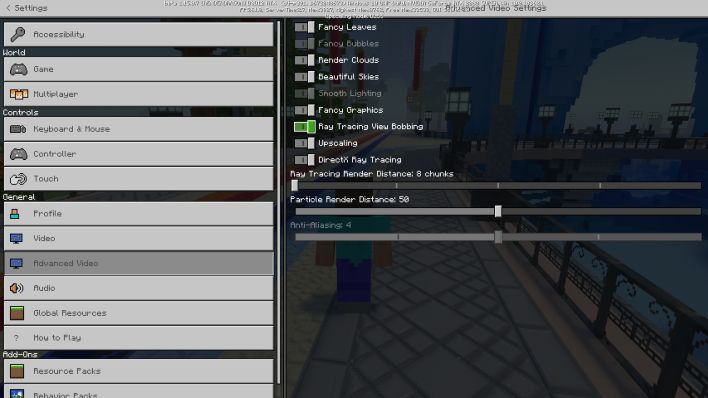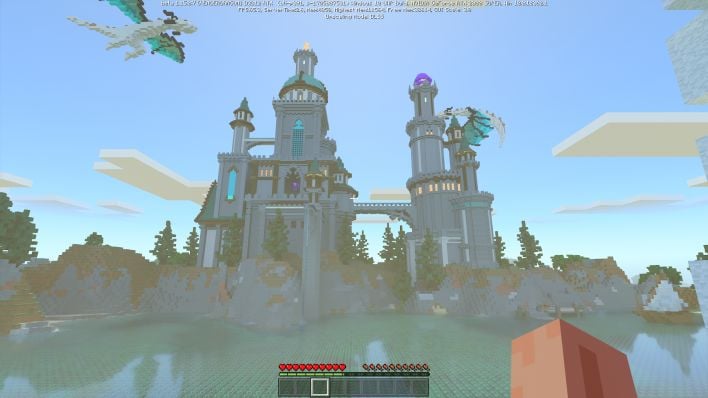Experiencing Minecraft RTX: A Whole New Ray-Traced World
Minecraft With RTX: Hands-On Beta Impressions Leave Us Slack-Jawed
It was seven months ago that NVIDIA announced it was working to give Minecraft a makeover, thanks to the ray tracing hardware acceleration hardware built into its GeForce RTX line of graphics cards. Well, unless you've been living under a rock -- or haven't been spending as much time on our news page as you should -- you know that Minecraft publisher Microsoft will make a beta of this new techology available to the public at 1 PM Eastern time today. We've been playing Minecraft RTX with its new graphics features the last few days, and now we can show you what it's all about.
While real-time ray tracing with DXR has been the headlining feature, NVIDIA and development studio Mojang have put in a lot of work into several new features. All of what you see here will be available in the beta, which is only for the Bedrock edition of Minecraft on Windows 10. It's been a while, but Microsoft and Mojang made that version of the game available as a free upgrade for Java edition players way back when it launched in 2015. Hopefully you took advantage of that, since these features will not be available in the older client.

Sunset in Of Temples and Totems RTX, one of six free ray-tracing enabled levels in Minecraft with RTX
In a word, and as you can see in the screenshots, Minecraft with RTX is beautiful. We've seen a wide variety DXR effects integrated into games to various degrees. For example, Battlefield V and Call of Duty have gone pretty light on the effects, mostly adding them for water reflections, fires, and explosions. On the other end of the spectrum, some games have gone all-in on a fully ray-traced render path, like Control. The implementation developed by NVIDIA and Mojang for Minecraft is much closer to Control than the other games. Ray tracing effects are everywhere from the rays of light that come through windows and skylights to glowing bricks that color the light of various rooms and shiny reflective surfaces. Here is a great example of Minecraft with RTX in action:
It doesn't really look like Minecraft as we think of it, with flat lighting, indistinct shadows and light positioning, or simple graphics. The added ray tracing features have added a new layer of complexity. As we've seen for the last few months, the lighting all by itself makes a big difference, but we'll also cover what else is new. First let's take a look at the playgrounds Mojang has put together with help from streamers and YouTubers in the Minecraft community.
New Minecraft With RTX Beta Lands Looking Pretty
Instead of just applying RTX to all the existing Minecraft realms programmatically and calling it a day, Mojang and NVIDIA worked with top Minecraft content creators to come up with six worlds, some of which are based on existing ones. You see, rather than apply something that will affect gameplay globally (and believe us, RTX really does affect gameplay when lighting is key), existing realms need to be converted to work with DirectX Ray Tracing (DXR). The beta has a total of six areas with tons of puzzles to solve and for players to explore.We recommend starting off in Color, Light, and Shadow created by NVIDIA and PearlescentMoon. This level has areas full of puzzles built around the ray tracing effects, and does a nice job of introducing players to what's new in the beta. In one area, we had to navigate from block to light-emitting block, stepping on them in the correct order to open up the ending. Without ray tracing turned on, it's impossible to complete the puzzle since the correct block emits light. Without ray tracing, blocks don't do that in Minecraft.

Another puzzle in the same level warns players at the start that it is not color-blindness friendly, since players have to be able to distinguish red and green. Completing the puzzle requires stepping on a series of switches that shine light though colored glass blocks, and after combining a couple of light rays, a colored patch on the floor matches the color hint on the walls. While this sort of thing would be possible without ray tracing, seeing the light shine in from different directions made it much more intuitive, and puzzles went from a series of trial and error to something we could actually figure out. To us it really enhanced the experience.
Of Temples and Totems RTX by Razzleberries is set in a South American jungle complete with trees, lava, and ancient ruins straight out of Indiana Jones and the Temple of Doom. Imagination Island has two huge palaces, courtyards, and even a giant ferris wheel to explore. Neon District wasn't available during the early access period, but from the materials NVIDIA has published, it looks pretty astounding.
All of these areas are available for free from the Minecraft marketplace in the game, but you'll really want to be sure there's a GeForce RTX GPU in your PC, because they won't make a whole lot of sense without it. On the other hand, folks who do own GeForce RTX hardware will probably be eager to get their hands on this beta, which still looks great, even in its unfinished state.
Physically-Based Rendering In Minecraft With RTX
Objects and materials found in Minecraft up until today have really only had two render properties: opacity and color. Opacity determines whether light passes through an object, and if so, how much. Glass is transparent, where wood, stone, lava, and foliage typically aren't. Color is also pretty self-explanatory. In the Minecraft with RTX beta, all of the objects in the game pick up some additional properties thanks to NVIDIA's push for Physically-Based Rendering (PBR). Most obvious is the emissive property, which causes objects to emit light. Now Minecraft can have glowing neon lights or fires that affect the lighting of the area around them.A little more subtle until you notice it is normal mapping, which is the process of "faking" geometric detail based on a texture and a second set of data points, which is used to calculate how light would hit that area of the texture. It allows added detail you can see without creating or rendering a bunch of geometry. It's a common technique used in 3D games over the last 15 years or so, and it's been available in Minecraft unofficially in a resource pack, but this is the first time it's come to the game officially.
The last two properties kind of go hand-in-hand: metallic and roughness. Both of these affect how light bounces off of a surface. Metallic surfaces reflect light directionally and in the right lighting can also show reflections. In the Color, Light, and Shadow realm there's an "infinite mirror" room where you can see multiple instances of the player character because the wall is perfectly reflective. Without ray tracing, it's just a large, featureless gray wall. Meanwhile, the rough, matte finish of stone diffuses light that bounces off of it, so all you see is the material, not a reflection.
Physically-based rendering techniques are required for RTX worlds. As we mentioned earlier, worlds need to be converted to be compatible with real-time ray tracing effects. Part of that conversion process means importing the PBR resource pack into the world. Without all the extra surface properties, the ray tracing effects just won't work. Mojang says it'll publish an unofficial conversion guide soon that will help players move their own content into the world of real-time lighting.
Deep Learning Anti-Aliasing
NVIDIA's AI-assisted anti-aliasing technique is in the Minecraft with RTX beta. Since this is a beta though, there's merely a toggle in Advanced Settings to turn DLSS on and off, and the setting is tied to the game's resolution for now. The Windows 10 version of Minecraft runs at the PC's desktop resolution, so to change resolution in-game, just change the desktop setting. If you have performance to spare, NVIDIA's Dynamic Super Reslution feature works just fine, and we could play at 4K with our 1440p monitor.Unlike other games that have DLSS 2.0, like MechWarrior 5 and Control, the DLSS setting is just a toggle without the different presets available. Mojang said that might change with the final release, but that hasn't been decided yet. As the game's resolution increases, Minecraft dynamically decreases DLSS quality. At 1080p, Minecraft with RTX uses the Quality preset, which renders the game using half the pixels and upscales using DLSS 2.0's algorithm. The game draws images with the Balanced preset when the native resolution of the game is 1440p, and drops down to Performance at 4K.
The minimum recommended spec for Minecraft with RTX is a GeForce RTX 2060, and both the desktop and notebook variants are supported. NVIDIA says that for the GeForce RTX 2060, it's targeting 1080p with DLSS turned on to get the frame rate into the 50s, and that panned out for us. Without DLSS, the game was still playable, but it was on the borderline, and generally hovered between 25 and 35 fps. The good news is that DLSS at 1080p looks wonderful. At first we didn't realize that the setting was enabled, because we didn't see any weird artifacts or other signs that the game wasn't being rendered at the native resolution.
DLSS 2.0 is on by default. Because this is a beta, performance has not been totally optimized. Despite that, the game runs smoothly on just about any RTX-enabled graphics card around. Since it looks so good, there's no reason to turn off DLSS in game unless you've got performance to burn for your given graphics card and display resolution. For example, if you have a GeForce RTX 2080 SUPER and a 1080p display, you can safely turn off DLSS, but you're not really gaining much in terms of perceived detail, and limiting the performance of the game.
Performance Testing
Speaking of performance, it goes without saying we had to see how well the game runs on a variety of graphics cards. We used the default graphics settings at the resolution listed below, and turned DLSS on and off at different resolutions. We're not doing super in-depth testing on a beta, but this should give folks with an entry-level RTX card, but we can report some averages by running the "hit the lit-up blocks" puzzle in Color, Light, and Shadow. This is instructive of what to expect in the beta, but may not apply to the finished product when it launches later this year. We tested on a system with a Ryzen 7 3700X and 32 GB of DDR4-3200 memory.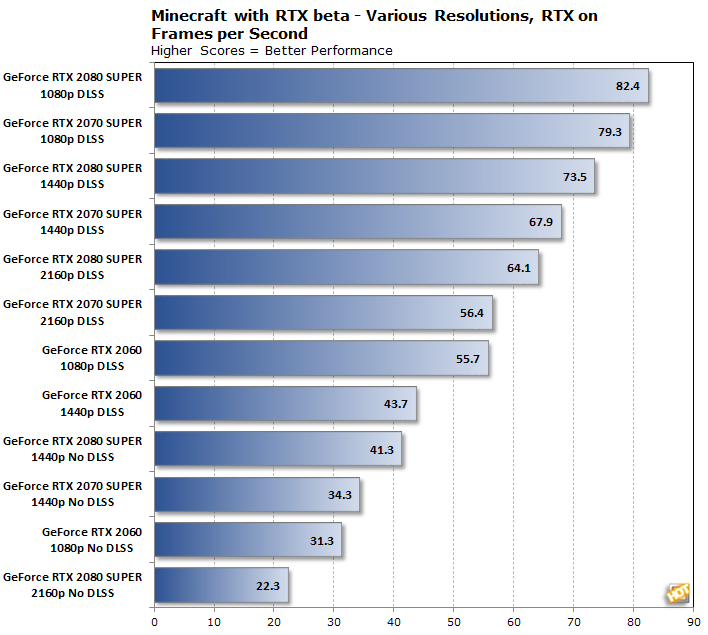
As it turns out the only really unplayable setting was native 4K on the GeForce RTX 2080, though if we'd been able to complete the run on the 2070 SUPER that would be listed here even lower. The great thing about DLSS and Minecraft's particular implementation is that so many resolutions are playable with minimal fuss on just about any level of hardware as long as the AI-assisted AA method is enabled. The non-DLSS setups all dropped to the bottom of the chart, as it seems the DLSS really improves performance. The GeForce RTX 2070 SUPER was more or less right on its heels at every turn, and thanks to its excellent performance it's a nice middle ground for a great Minecraft with RTX experience, at least in the beta.
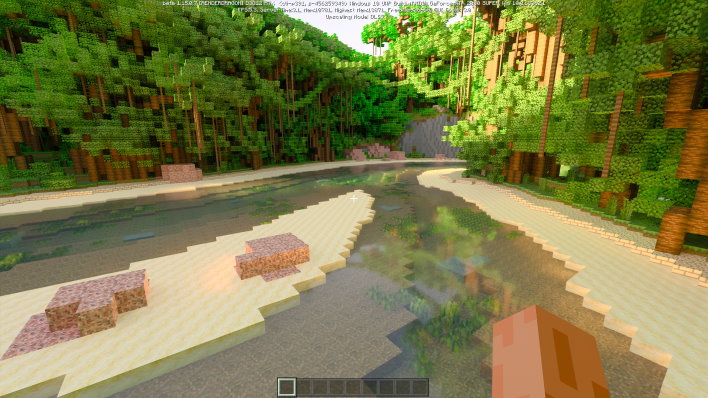
Turning up the render chunks is pretty gorgeous, but frame rates will take a hit
If your preferred resolution and graphics card leave some untapped performance on the table, you can crank up the draw distance. By default, the game renders a distance of eight "chunks" of terrain before fading the distant horizon into a fog to prevent pop-in. This can be cranked all the way up to 24, and it makes a big difference. In the screenshot below, the far-off dragon tower was completely invisible, but turning up the render distance made it clear as day. This does take a toll on performance, however. With all that render distance and tons of reflective water, we inadvertently brought frame rates down into the single digits. But remember, this is a pre-release version of the game, and NVIDIA and Mojang say it's still being tuned.
Minecraft RTX Beta Impressions Wrap-up
Minecraft with RTX is a pretty spectacular experience, even for the Minecraft-uninitiated. The beta update does seem to upend the idea of simple graphics that run on just about any hardware. On the other hand, NVIDIA's ray traced rendering techniques bring with them the possibility for new game types. The game's six RTX-enabled worlds created in partnership with some of the best-known creators in the game's community show off some of the possibilities. New physically-based material rendering properties give objects in the game a real sense of presence and space.Light shining through open windows, through glass cubes, and reflecting off metallic surfaces adds a new sense of immersion to an old, familiar friend. What's wild about how good this beta looks is that Minecraft is not full of detailed textures and complex geometry. If anything, Minecraft with RTX is proof that none of that matters when a game has a consistent art style and amazing lighting. Thanks to some really stunning fully path-based ray tracing effects, Minecraft has exactly that.
However, we all know that the heart and soul of Minecraft is based around what other people make of their game worlds. We're excited to see what the community will do with these new tools. The beta opens at 10AM PDT today, and this article represents just a taste of what's out there. We heartily recommend that everyone who already plays Minecraft and owns GeForce RTX hardware should give it a try. We're also pretty sure that because of Minecraft's enormous draw, lots of GeForce RTX graphics cards will start flying off store shelves as the final release—a free update to the game—draws near later this year, too.

